+86 17727759177
inbox@terli.net
- All
- Product Name
- Product Keyword
- Product Model
- Product Summary
- Product Description
- Multi Field Search
Views: 0 Author: Site Editor Publish Time: 2025-08-21 Origin: Site
When considering solar panel installation cost Texas 2025, you can expect to pay between $17,500 and $25,000 before incentives. After applying the federal tax credit, most homeowners end up paying around $12,000. Texas stands out for solar panels, ranking second in the nation for solar power and first for projected future solar growth. The federal tax credit can help you save significantly if your solar panel installation is completed by December 31, 2025. With these incentives and Texas’s abundant sunshine, now is an excellent time to take advantage of solar panel installation cost Texas 2025 and start saving money.
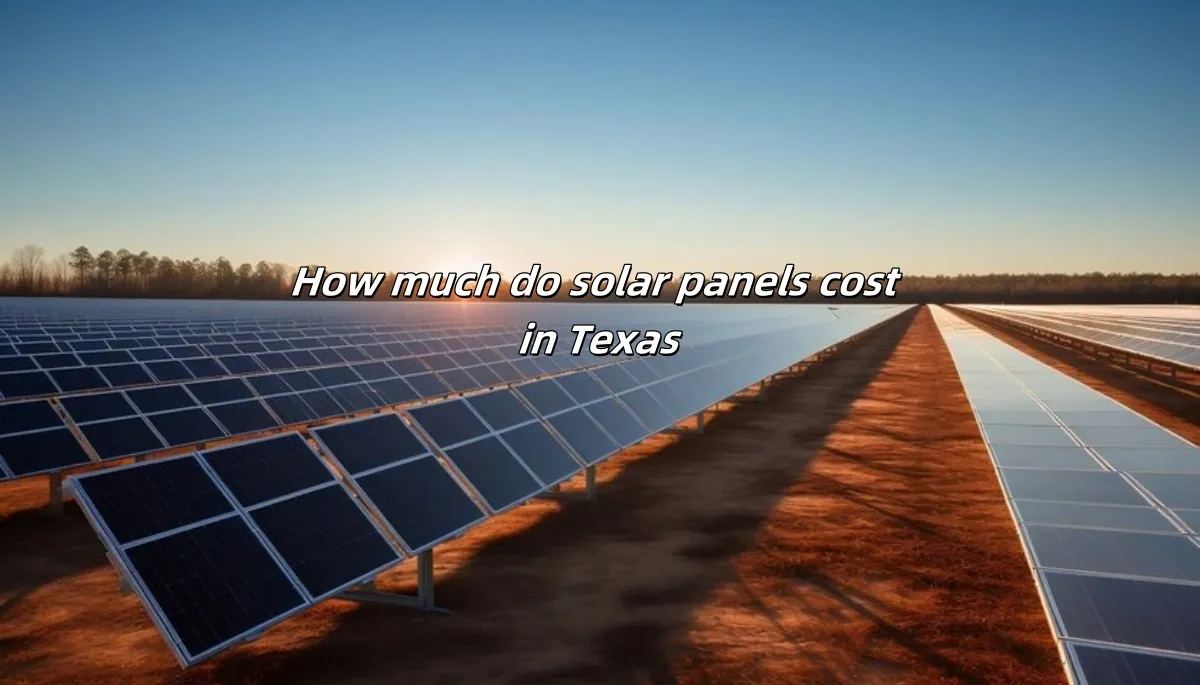
In Texas, solar panel installation costs from $17,500 to $25,000 before incentives. The federal tax credit can lower the cost to about $12,000. Larger solar systems lower the price for each watt. Bigger systems save more money over time. Texas has good incentives like a 30% federal tax credit. There are also property tax exemptions and local rebates. These can cut your solar costs by up to 60%. Picking the right installer is important. Choose certified and experienced companies. Look for good reviews and clear prices to get the best deal. Solar panels help save money by lowering electric bills. They also raise home value by 2–3%. Most solar panels pay for themselves in 6 to 10 years.
You can measure the price of solar panels in Texas by looking at the cost per watt. In 2025, the average cost per watt for solar panel installation in Texas is about $2.84 after you apply the federal tax credit. Larger systems usually have a lower cost per watt, which means you save more when you install a bigger system. Here is a table showing the average cost per watt for different system sizes:
| System Size (kW) | Average Cost per Watt (USD) |
|---|---|
| 4 | 3.40 |
| 5 | 3.15 |
| 6 | 2.98 |
| 7 | 2.86 |
| 8 | 2.77 |
| 9 | 2.70 |
| 10 | 2.65 |
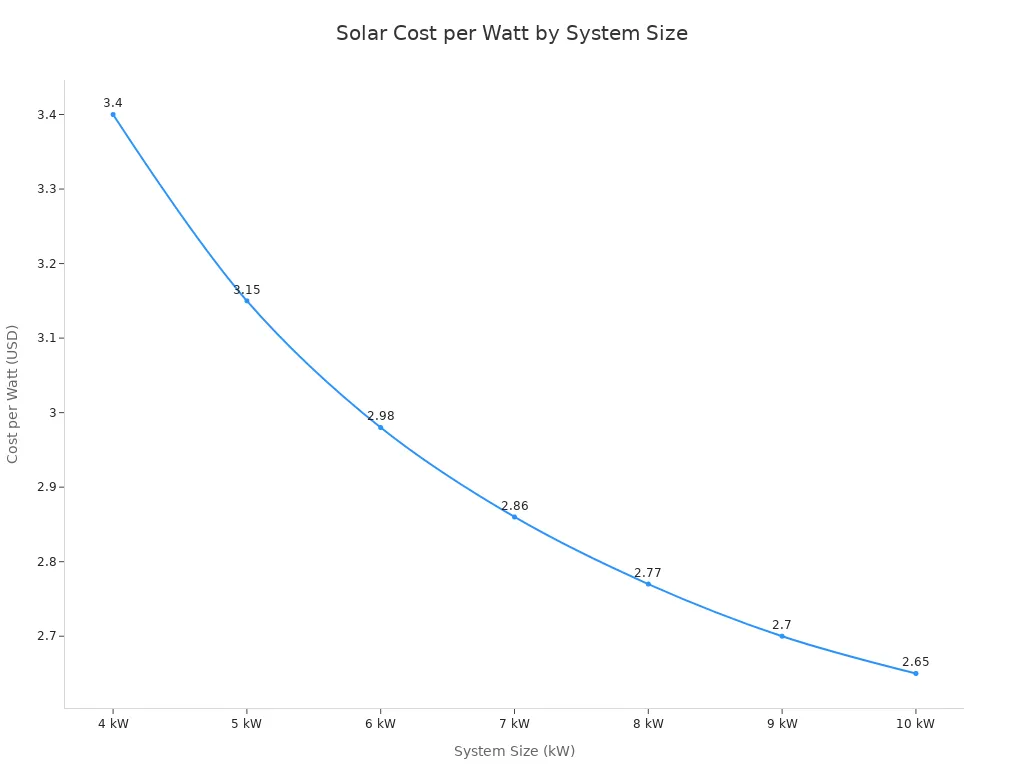
If you want to lower your solar panel installation cost texas 2025, you should consider a larger system. The price per watt drops as the system size goes up, making solar panels cost less for each unit of energy.
The total cost of solar panels in Texas depends on the size of the system you choose. Most homes need a system between 6 kW and 14 kW to cover their electricity needs. The cost of solar panels rises with system size, but the cost per watt goes down. Here is a table showing the cost of solar panel installation for different system sizes before incentives:
| System Size (kW) | Cost per Watt (USD) | Total System Cost Before Incentives (USD) |
|---|---|---|
| 6 | 3.46 | 14,545 |
| 8 | 3.40 | 19,021 |
| 10 | 3.33 | 23,310 |
| 12 | 3.26 | 27,413 |
| 14 | 3.20 | 31,329 |
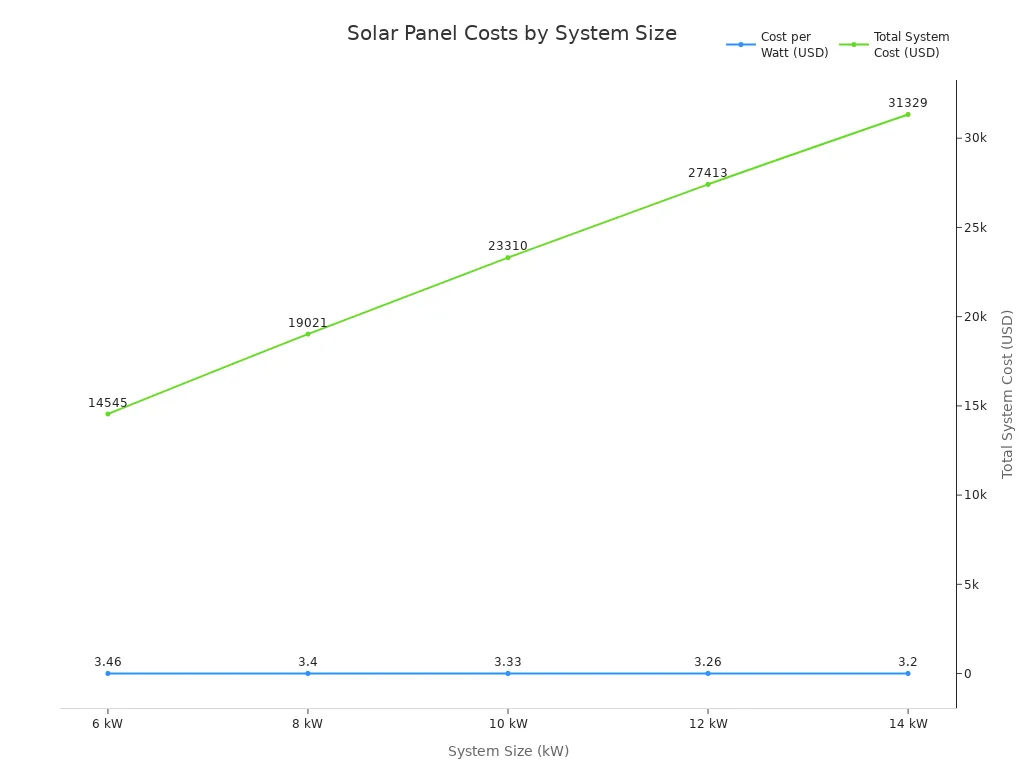
After you apply the 30% federal tax credit, the cost drops a lot. For example, a 9.72 kW system costs about $27,296 before incentives and about $19,107 after the tax credit. Texas also offers property tax exemptions for solar installation, so you do not pay extra property taxes because of your solar panels. These incentives make the cost of solar panels much more affordable.
If you live in a major city like Austin, Dallas, or Houston, you will see similar prices. Here is a table showing the average solar panel installation cost texas 2025 for different system sizes in these cities:
| System Size (kW) | Average Total Cost (Before Tax Credit) | Average Cost After 30% Federal Tax Credit |
|---|---|---|
| 3 kW | $7,800 – $9,000 | $5,500 – $6,300 |
| 4 kW | $10,400 – $12,000 | $7,300 – $8,400 |
| 5 kW | $13,000 – $15,000 | $9,100 – $10,500 |
| 6 kW | $15,600 – $18,000 | $10,900 – $12,600 |
| 7 kW | $18,200 – $21,000 | $12,700 – $14,700 |
| 8 kW | $20,800 – $24,000 | $14,600 – $14,700 |
| 9 kW | $23,400 – $27,000 | $16,400 – $18,900 |
| 10 kW | $26,000 – $30,000 | $18,200 – $21,000 |
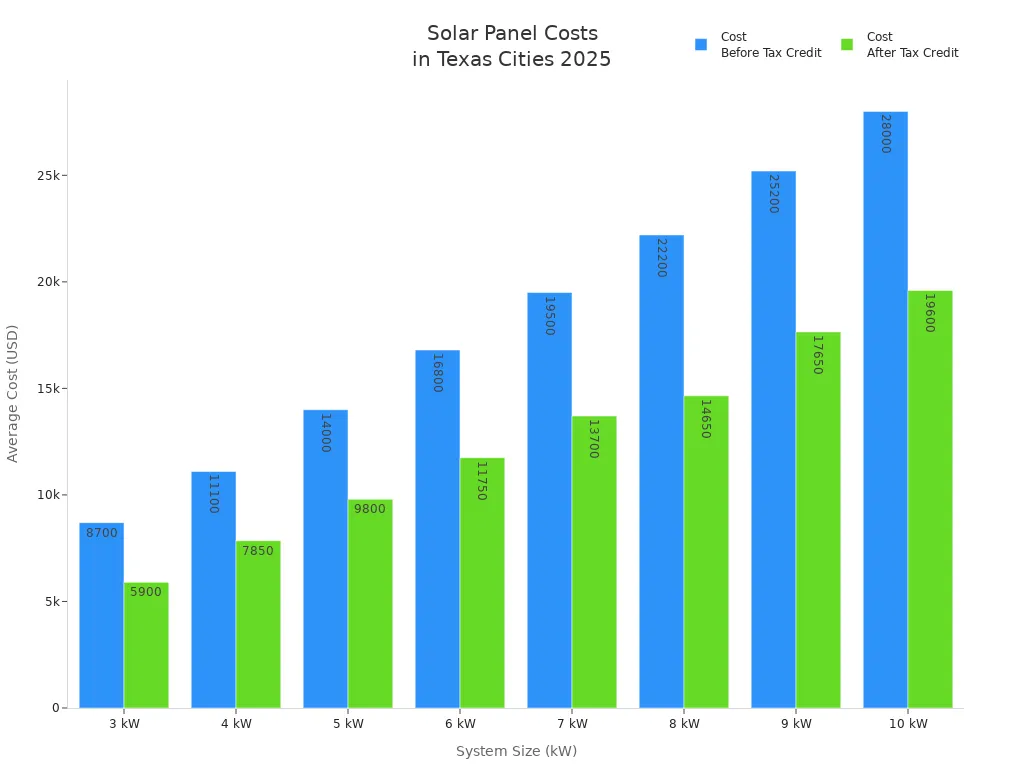
You will notice that the solar panels cost in Texas does not change much from city to city. Most homes need an 8 to 10 kW system to meet their energy needs. Texas gets over 200 sunny days each year, so solar installation is a smart investment.
You might wonder how the solar panel installation cost texas 2025 compares to the rest of the country. Texas has a lower cost per watt than the national average, but homes in Texas often need bigger systems. This means the total cost of solar panels in Texas is higher than the national average, even though the price per watt is less. Here is a table comparing Texas and the national average:
| Metric | Texas (2025) | National Average (2025) |
|---|---|---|
| Cost per watt | $3.18 | $3.33 |
| Average system size (kW) | 11.5 | 9 |
| System cost before tax credit | $36,570 | $29,970 |
| System cost after 30% federal tax credit | $25,599 | $20,979 |
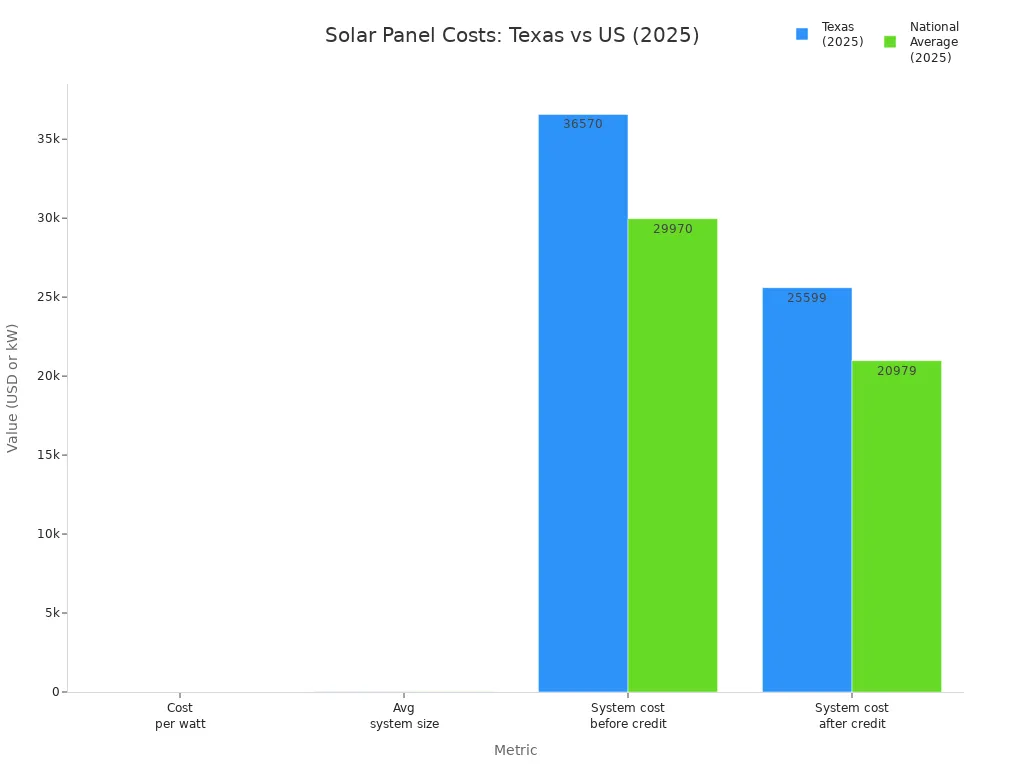
You pay less per watt for solar panels in Texas, but you need a larger system to cover your energy use. The cost of solar panels is higher overall, but you get more energy and bigger savings over time. The solar panel installation cost texas 2025 is still a good deal because of the strong sunlight and helpful incentives.
Tip: If you want to get the best value, compare quotes from several installers. Ask about local rebates and incentives to lower your solar panel installation cost even more.
Your home's energy use affects solar panel cost. Look at old electricity bills to see how much power you use. If you charge an electric car or have a pool, you need a bigger solar system. This means you pay more at first. Other things also change the price:
If your roof is hard to work on, labor costs go up.
How much sun your roof gets and its shape change how many panels you need.
The type and brand of solar panels in texas can change the price. Better panels last longer and have better warranties.
Tip: Check your energy use before picking a system size. This helps you not buy more than you need.
The equipment you pick for your solar system changes price and how well it works. Here are some things to know:
Monocrystalline panels cost more because they are heavy and need strong support.
Thin-film panels are light and cheaper to put up, so labor costs are less.
Monocrystalline panels work better but cost more at first.
Cheaper panels save money now but may not save as much energy later.
Adding solar batteries or brands like Tesla Powerwall makes the total cost higher.
Each extra kilowatt adds about $3,330 to your cost.
Who installs your solar panels and local rules change the cost. Some cities have slow or tricky rules for permits. This can make your project take longer and cost more. Installers may charge more—over 10%—to cover these steps. Good installers know local rules and help you avoid delays and extra costs. New companies may have trouble with permits, which can make you pay more.
Permit fees and rules are different in each city.
Some places need you to apply in person, which takes longer.
Local rules about fire safety or looks can add to your cost.
Note: Always get quotes from a few installers. This helps you find the best price and avoid hidden costs.
Incentives can lower the final cost of your solar system. The 30% federal tax credit cuts the price for most people. Local rebates and net metering can save you even more. For example, a 6-8 kW system in texas may cost $15,000 to $22,500 before incentives. After the tax credit, you pay $10,500 to $15,750. Local rebates can save you another $2,500 to $6,000, depending on your provider. Net metering lets you earn credits for extra energy your system makes, so you pay off your system faster.
| Incentive Provider | Incentive Type | Maximum/Rebate Amount |
|---|---|---|
| San Marcos Electric Utility | Solar PV Rebate | Up to $2,500 |
| AEP Texas North Company | SMART Source Solar PV Rebate | Up to $6,000 |
| AEP Texas Central Company | SMART Source Solar PV Rebate | Up to $5,000 |
| Oncor Electric Delivery | Residential Solar Program | Rebates for eligible projects |
| Denton Municipal Electric (DME) | Solar Rebate | Average $4,000 |
| New Braunfels Utilities | Solar Rebate | Up to $3,000 |
| Garland Power & Light | Buyback Program (Net Metering) | $0.0669 per kWh for excess energy |
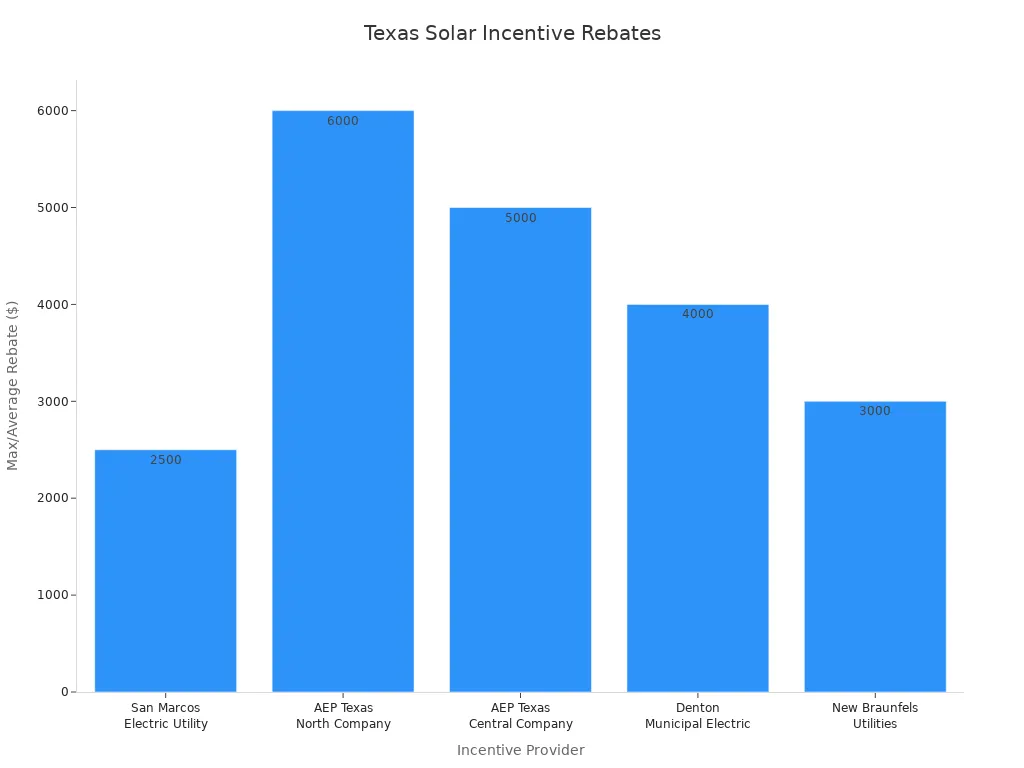
Solar incentives in texas can cut your starting costs by 30-60%. This makes solar systems easier to buy for homeowners.
You can save money on solar panels with the federal tax credit. This credit is also called the federal investment tax credit. It lets you get back 30% of your total solar costs on your federal taxes. The credit covers things like hardware, labor, and other installation costs. There is no maximum limit, so you can claim 30% no matter how big your system is. The federal tax credit works for systems installed from January 1, 2022, to December 31, 2032. After 2032, the credit goes down to 26% in 2033 and 22% in 2034. The program will end in 2035.
To get the federal solar tax credit in Texas, you must:
Own the home where you put the solar panels.
Use the system at your main or second home.
Have the system working by the deadline.
Use the credit on your federal income tax over many years if needed.
The federal tax credit is a great way to save money on solar. You can save thousands of dollars on your solar project.
Texas gives you a property tax exemption for solar panels. This means you do not pay more property taxes if your home value goes up from solar panels. The exemption covers all the extra value from solar panels or solar water heaters. You must own the system to get this benefit. If you lease your system, you do not get the exemption.
| Aspect | Details |
|---|---|
| Exemption Name | Texas Renewable Energy Systems Property Tax Exemption |
| Exemption Benefit | 100% exemption of increased appraised property value from qualifying solar energy systems |
| Ownership Requirement | Must own the solar system (leased systems do not qualify) |
| Usage Requirement | Used for producing and distributing energy on-site |
| Application Deadline | April 30th of the year exemption is requested |
Tip: Turn in your application before April 30th to get your property tax exemption for the year.
Many cities in Texas have local incentives and rebates for solar. These programs help you pay less at the start. Here are some big local incentives:
| Program / Incentive Name | Location / Utility Area | Incentive Details |
|---|---|---|
| Austin Energy Residential Solar PV Rebate | Austin | Up to $2,500 rebate for solar systems 3 kW or larger |
| Oncor Residential Solar Rebate Program | Dallas-Fort Worth, Midland | Up to $9,000 estimated incentive for systems 3 to 15 kW with battery storage |
| SMART Source Solar PV Program (AEP Texas) | West and South Texas | Up to $3,000 one-time incentive for systems up to 30 kW |
You must follow each program’s rules, like using approved contractors or taking a solar class. These local solar tax incentives and state incentives make solar cheaper.
Net metering lets you get credits for extra electricity your solar panels make. Texas does not have a statewide net metering law. But many utilities and electric companies have solar buyback plans. These plans pay you for extra power you send to the grid. Some pay the full retail rate, but others pay a lower or market rate.
| Electricity Provider | Plan Name | Solar Buyback Rate | Notes |
|---|---|---|---|
| Chariot Energy | Shine | Up to 25¢/kWh (market rate) | Credits roll over monthly |
| Gexa Energy | Solar Export | 3.00¢/kWh | Credits roll over monthly |
| Austin Energy | Value of Solar | Varies (VOS tariff) | Credits based on total solar generation |
Note: Look at different solar buyback plans to find the best one for your home. The right plan can help you save more money from solar incentives.
When you think about paying for solar panels, you have two main choices. You can pay with cash or get a solar loan. If you use cash, you own the solar system right away. You get all the energy savings and tax credits. There are no monthly payments, but you must pay everything at once.
Solar loans let you pay over time. You still own the system, so you can get the 30% federal tax credit and local rebates. Monthly payments make it easier to afford solar panels. Many loans have low interest rates and flexible payment plans. Both cash and loans can help your home’s value go up.
| Aspect | Cash Purchase | Solar Loans |
|---|---|---|
| Ownership | You own the system | You own the system |
| Upfront Cost | High | Low to none |
| Tax Credit Eligibility | Yes | Yes |
| Maintenance | Your responsibility | Your responsibility |
| Impact on Home Value | May increase | May increase |
Tip: If you want to save the most and have full control, owning your system with cash or a loan is best.
Some ways to get solar panels do not mean you own them. With a solar lease, a company owns the panels. You pay a set fee each month to use the energy. With a Power Purchase Agreement (PPA), you pay for the electricity the panels make. This is usually cheaper than your normal electric bill. The solar company takes care of repairs and maintenance.
Leases and PPAs do not cost much at the start. But you cannot get the federal tax credit or most local rebates. This is because you do not own the system. These options can lower your electric bill, but you save less money over time.
| Aspect | Solar Lease | PPA |
|---|---|---|
| Ownership | Company owns system | Company owns system |
| Upfront Cost | None | None |
| Tax Credit Eligibility | No | No |
| Maintenance | Company handles | Company handles |
| Impact on Home Value | No impact | No impact |
How you pay for solar panels changes your savings and incentives. If you own your system, you can get the 30% federal tax credit and most local rebates. This lowers your total cost and helps you save more money. Leases and PPAs do not get these incentives, so you save less.
Paying upfront gives you the most savings in the long run.
Solar loans let you pay over time and still get incentives.
Leases and PPAs have low starting costs but fewer benefits.
Note: Local rebates often come before the federal tax credit, so owning your system is even better in Texas.
It is important to pick a good solar installer for your home. In Texas, some companies are known for great service and lots of experience. They also have strong warranties. These companies can help with battery storage and EV charger setup. You can look at the table below to compare them:
| Rank | Company Name | Key Strengths and Offerings |
|---|---|---|
| 1 | Momentum Solar | Over a decade of experience, flexible financing options, expert knowledge of texas solar incentives. |
| 2 | NRG Clean Power | 30+ years in business, offers solar panels, battery storage, EV chargers, and maintenance; 0% down payment plans. |
| 3 | Longhorn Solar | Family-owned, based in Austin, NABCEP certified, award-winning customer service, roof repair and replacement. |
| 4 | Elevation | Holistic energy solutions, combines solar installation with energy management systems. |
| 5 | Fusion Power | Regional focus, offers solar panels, battery storage, EV chargers, and innovative financing programs. |
These companies get high ratings on BBB and Google Reviews. They give you strong warranties, like 25 years for products and performance. Workmanship is covered for at least 10 years. You can get a free consultation and clear prices. This helps you make a smart choice.
You need to find a trusted solar company in Texas. Here are some tips to help you choose the right one:
Look for certifications like NABCEP. Make sure the company is licensed, bonded, and insured.
Pick installers with five or more years of experience and many finished projects.
Read reviews on Solar Reviews, BBB, and Google to see what others say.
Ask for a full cost breakdown. Make sure you know about the equipment and warranties.
Get quotes from different companies and compare the cost per watt.
Local companies often know more about Texas rules and incentives.
Make sure the company does its own work, not just hiring others.
Choose companies with good workmanship warranties and system guarantees.
Stay away from deals that sound too good, like very low prices or unclear loans.
Tip: Ask people you know or local solar owners for advice. Companies with good reviews and clear answers are usually trustworthy.
You can see big solar savings when you install residential solar panels in Texas. Most homeowners save between $1,800 and $2,400 every year. Over 25 years, your total savings can reach about $32,651 after you pay for your system. If you have a larger residential system, you save even more. For example, a 5 kW system saves you about $990 each year and up to $86,978 over 25 years. Many people notice their electric bills drop by $150 to $200 each month. Some homeowners in Plano saw their bills go down right away and watched their savings grow as electricity rates increased.
| System Size (kW) | Estimated Annual Savings (USD) | Estimated 25-Year Savings (USD) | Payback Period (Years) |
|---|---|---|---|
| 5 | ~$990 | ~$86,978 | 9.0 |
| 10 | ~$1,980 | N/A | 8.0 |
| 12 | ~$2,376 | N/A | 8.1 |
| 15 | ~$2,970 | N/A | 8.0 |
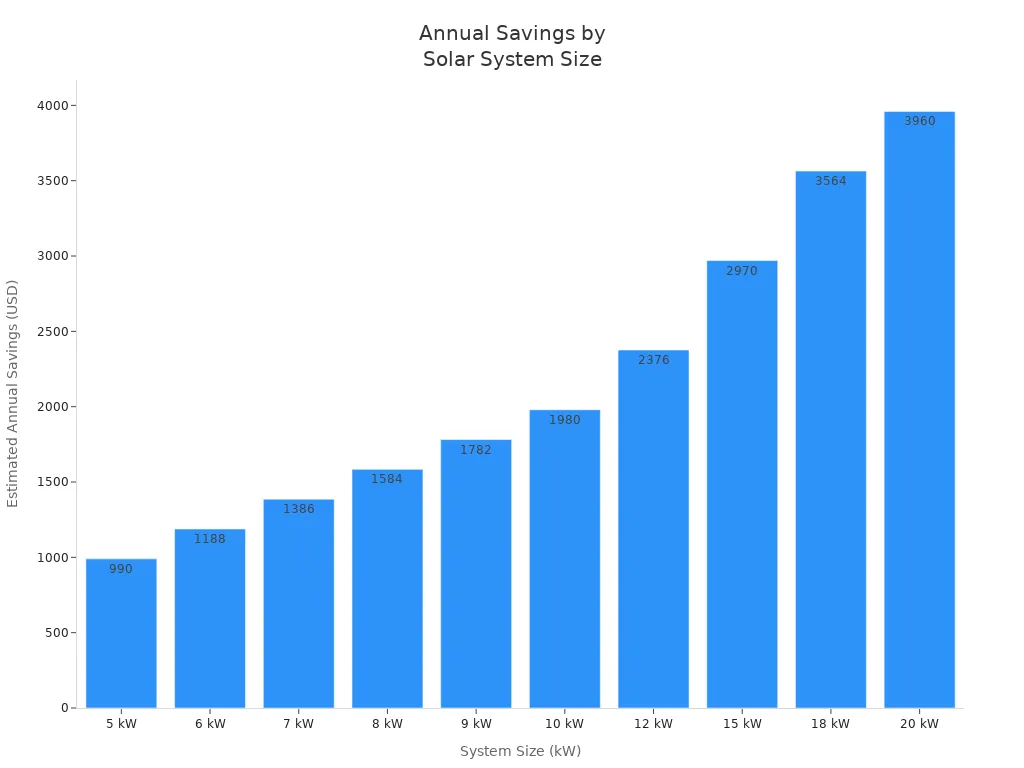
Tip: You can save money on solar panels by choosing the right system size for your home.
You want to know how long it takes to get your money back after buying residential solar panels. Most people in Texas reach the payback period in 6 to 10 years. Some pay off their systems in as little as 5 years, while others may take up to 15 years. The payback period depends on your system size, electricity rates, and incentives. If you install a bigger system, you pay more at first but save more each month. Texas has lots of sunshine, so your solar panels work well and help you reach payback faster. You can figure out your payback period by dividing your net system cost by your yearly savings.
Higher electricity rates mean faster payback.
Federal and local incentives lower your upfront cost.
Net metering and solar renewable energy certificates add to your savings.
Installing residential solar panels can make your home worth more. In Texas, homes with solar panels usually sell for 2–3% more. If your house is worth $300,000, you could see a boost of $5,000 to $10,000. Solar homes often sell faster, sometimes up to 20% quicker than homes without solar. Appraisers look at your system size, age, and if you own the panels. Owned systems add more value than leased ones. Buyers in Texas like homes with solar because they want lower energy bills and care about sustainability. If you keep your system in good shape, you help your home stand out in the market.
Note: Solar panels are a smart investment for residential homeowners in Texas. You get solar savings, lower bills, and a higher home value.
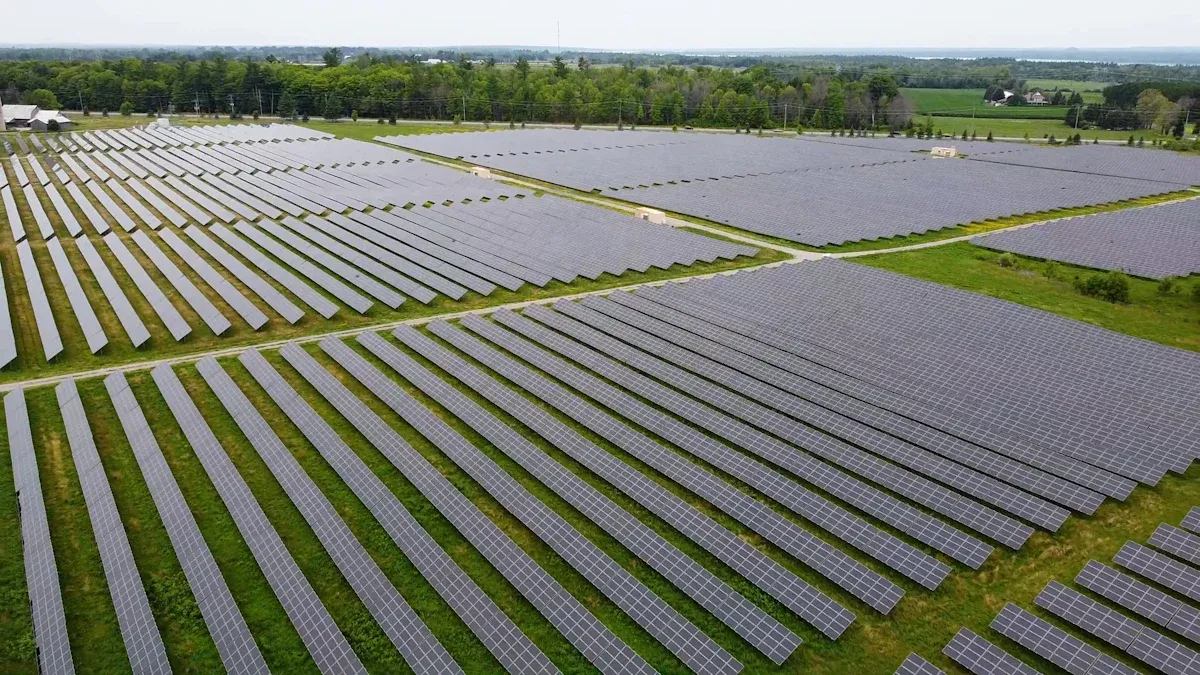
Image Source: pexels
Solar panel prices in Texas have gone down a lot in ten years. The average cost to put in solar panels is now over 70% less. For example, a 6 kW system costs about $16,000 before incentives. After the federal tax credit, it is around $11,200. This big price drop makes solar energy easier for homeowners to buy. In 2022, Houston’s average cost per watt was about $2.83. Experts think prices will keep going down. By 2030, solar panels could cost less than half of today’s price. This means you might pay even less for solar in the future.
Texas is a top state for solar energy. The state gets more than 300 sunny days each year. This helps solar panels work better. Solar installation costs are lower here than in most other states. Even though the national market dropped a little in early 2025, Texas keeps adding more solar power. There may be some small changes in the short term, but experts think growth will continue until 2030. New energy storage projects and a strong solar market help more people use solar.
Note: Texas has many new solar projects planned, so more homes will likely get solar power soon.
You may wonder if solar incentives will change soon. Right now, Texas has not made big changes to its solar programs. The state set new clean energy goals in 2021. It wants 28% clean energy by 2030 and 40% by 2035. Local utilities and cities still give rebates and buyback programs. Texas does not have a state solar tax credit. Net metering rules depend on your electric company. Most experts think current incentives will stay the same for a few years. If Texas needs to reach its clean energy goals, there could be more help for solar later.
Local rebates and utility programs are still offered.
No big statewide incentive changes are coming soon.
Net metering rules might get better if clean energy goals are not met.
You can save up to 30% on your solar installation with the federal tax credit if you get your system before December 31, 2025. The table below shows how much you can save with rebates and credits:
| Incentive | Value/Rate |
|---|---|
| Federal Tax Credit | 30% of system cost |
| Oncor Solar Rebate | Up to $9,000 |
| AEP Texas Rebate | Up to $3,000 |
First, compare prices from certified installers. Use online tools to see if your home is good for solar. Look at different ways to pay for your system. If you act soon, you can get the best deals and avoid higher prices later.
Most solar panels work for 25 to 30 years. You can expect strong performance for decades. Texas weather does not damage panels easily. Regular cleaning helps keep them working well.
Solar panels still make electricity when clouds cover the sun. You get less power than on sunny days. Texas has many sunny days, so you see good results most of the year.
You can put solar panels on most roofs. Flat, sloped, and metal roofs work well. Your installer checks your roof’s shape and strength before starting. Some old roofs may need repairs first.
You send extra electricity to the grid. Many Texas utilities give you credits or pay for this power. Net metering or buyback plans help you save more money.
Solar panels need little care. You clean them a few times each year. Your installer checks for problems during regular inspections. Most panels come with long warranties for peace of mind.